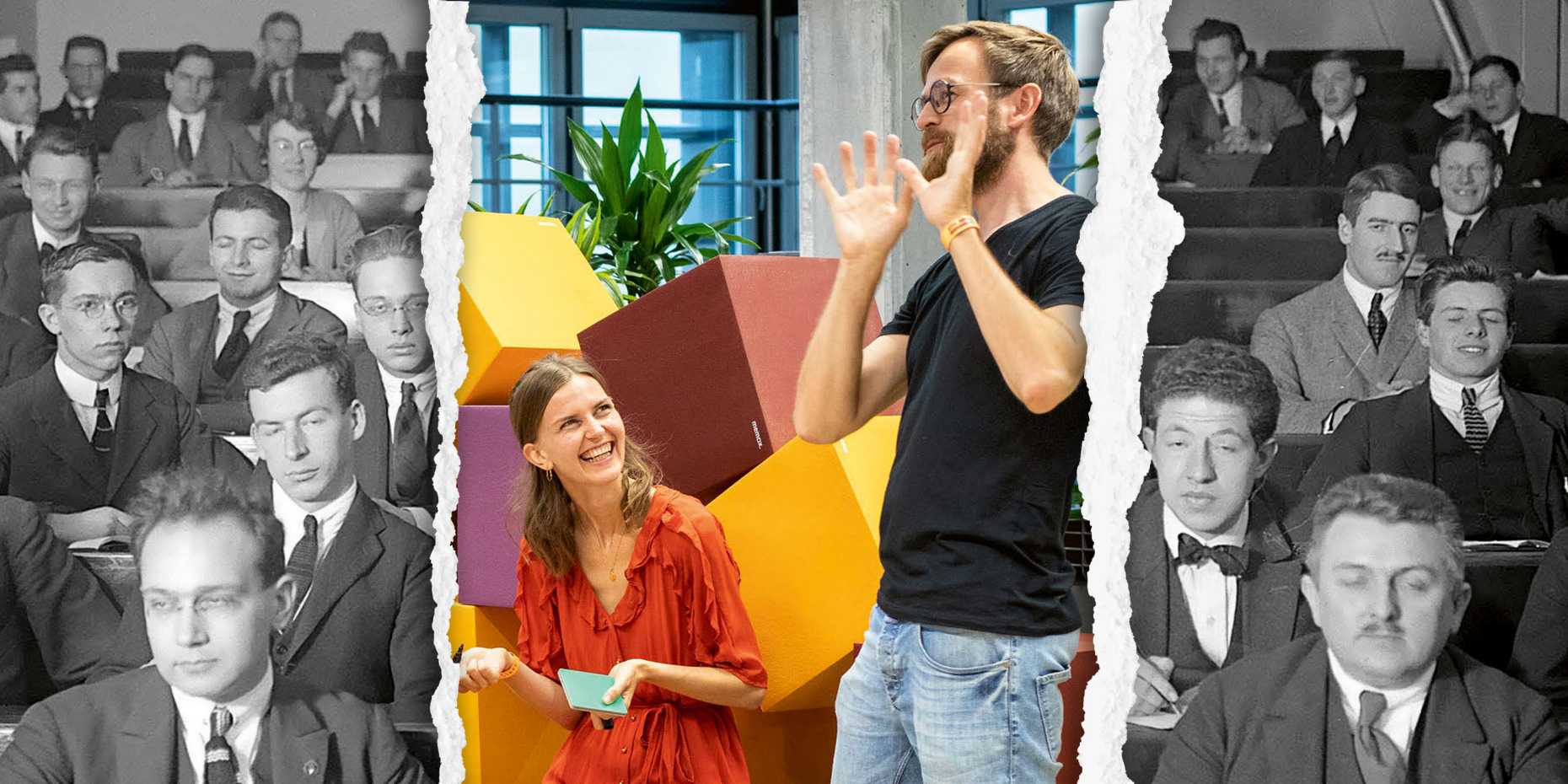A laboratory for society
ETH Zurich has always been a mirror of new social developments. In the past 20 years, the university has become more international, increasingly autonomous, more digital – and less male.

For over two centuries, the twin roles of the European university have been to research the new and teach the known. On inspection of these two educational mainstays, our universities would appear to be exceptionally durable institutions. Yet a closer look reveals a string of key changes down the years – both in the way that universities perform these tasks and how they conceive of their role.
Throughout its eventful history, ETH Zurich has consistently shown its capacity to respond and adapt to any new social, economic and political developments that impact its sphere. In the past 20 years, ETH Zurich has not only become more international, more autonomous and increasingly digital – it has also become more innovative and less male-dominated. At the same time, in researching new technologies and ensuring their transfer to society, it has remained a key driver of change. In this sense, ETH is not only a reflection of society; it is also a laboratory for new societal trends.
Greater networking, more mobility
In its basic outlook, science has always been universal and therefore supranational. Over the last two decades, however, the academic world has suddenly become much more international in its activities and organisation. The reasons for this are complex and varied. For a start, globalisation has led more and more people to look beyond their own national borders to secure the very best conditions for study or research. At the same time, some countries – especially smaller ones – have found themselves unable to meet the growing demand for researchers from their own finite pool of labour.
By the 1980s, Switzerland too had become a member of the “knowledge society”. This was the moment when knowledge became a major driver of growth and innovation – not just in the service sector, but also in industry. Things really took off in the early 1990s with the emergence of key new fields of technology such as molecular biology, microelectronics and computer science. It soon became clear that, in the long term, Switzerland would need to enlist the help of scientists from abroad in order to keep pace with the world’s best.
A global contest for talent

In Die Zukunftsmaschine (“The Future Machine”), his canonical work on the history of ETH Zurich, ETH professor David Gugerli says that ETH recruitment policy began adapting to this new reality as early as the 1990s. Back then, the global competition for talent was already well under way – a battle that has only intensified since the turn of the new millennium, with added pressure from increasingly self-assured Asian universities.
To gauge how successful ETH has been in this respect, a look at the statistics is instructive. In the early 1980s, fewer than 30 percent of ETH professors were from abroad; by 2020, this proportion had risen to 67 percent. The picture is similar with regard to doctoral students: in 1990, two out of every three doctoral students were from Switzerland; by 2020, three-quarters came from abroad. Naturally, the increasingly international nature of the research conducted at ETH has also impacted its relations on other levels.
As Gugerli explains, the networks inhabited by ETH researchers have become increasingly international. Like the Swiss corporate sector, the academic world has seen a progressive erosion of its national networks – a trend that ETH then offset by strengthening its ties to institutions and partners abroad. At the time, there were some conservative voices, both in politics and society, who went as far as to say that ETH had abandoned its national roots.
The recruitment of women at ETH Zurich has proved far less successful. It was not until 1985 that the first woman – architect Flora Ruchat-Roncat – was appointed to a full professorship. As of 2020, 18 percent of all professors were women; for students, this proportion stood at 33 percent. In other words, ETH still has a long way to go before it achieves a balanced gender ratio in research and teaching.
A growing internationalisation
Over the past 20 years, global competition to secure the best students has likewise increased. For Antonio Loprieno, President of the European Federation of Academies of Sciences and Humanities, two developments stand out. On the one hand, there was the Bologna Reform, launched in 1999 and completed in 2005. This led initially to a harmonisation of European degree programmes in line with the North American Bachelor’s/Master’s system. Some voices criticised what they saw as an overly regimented, “school-like” approach. According to Loprieno, however, “the creation of a unified sphere of higher education, whereby different study programmes suddenly became comparable through the system of ECTS credits, has increased student mobility.”
In parallel, the early 2000s saw the introduction of a new university ranking system. While this made institutions of higher education internationally comparable, it paid little attention to national particularities and has therefore remained flawed to this day. “These two developments led to a globalisation of higher education,” says Loprieno, “and made the university, as an institution, more international.” Institutions that enjoyed a good ranking, such as ETH Zurich, thus became even more attractive – with the result that the proportion of foreign students at ETH leapt from 20 to 40 percent between 2000 and 2020.
“ Promoting innovation is increasingly how universities seek to compete against rival institutions. ”Antonio Loprieno
Self-determination
In the international battle for brains, funds and ranking points, universities needed to be as efficient and as flexible as possible. With the advent of the 21st century, they were therefore granted financial and administrative autonomy. “This promise of greater autonomy was underpinned by concepts from new public management,” Gugerli explains. The hope was that by giving institutions overall responsibility for providing the expertise to deliver education and research, there would be corollary political, economic and academic benefits.
This was the logic that led to ETH being granted budgetary independence in 2004. From then on, it had the freedom to fully dispose over whatever resources were available to it. In retrospect, it is hard to imagine that universities were once rather like government departments, embedded in their own national system of bureaucracy. In an increasingly competitive education market, where fast decisions and flexible funding are paramount, this model came to be seen as increasingly ineffective.
Rise of outside funding

As Loprieno explains, this growth in university autonomy was accompanied by an increasing focus on performance indicators and by a diversification in funding. Third-party funds secured from national and international sources came to play an increasingly important role, as did grants from the private sector. Some welcomed this greater flexibility and entrepreneurial scope; others thought it smelled of commercialisation and a greater dependency on private-sector interests. In 2004, ETH Zurich set up the ETH Foundation with a view to improving its reach among private donors and benefactors.
Around the same time as ETH was granted autonomy, many of its administrative processes began to migrate online. This progressive digitalisation of university life started with course registration and now extends to staff recruitment. Last year, it culminated in the measures made necessary by the COVID-19 pandemic, where teaching shifted to the virtual realm. At the same time, it is increasingly evident that the ability to process large volumes of data, with powerful computers and ever-better algorithms, will have a lasting impact on a broad swathe of research.
Europeanisation of research
The research community has always been international in its nature but, over the last ten years, has undergone a veritable Europeanisation. A key driver of this trend has been the European Research Council (ERC), founded in 2007. “For the first time ever, the ERC created genuine competition among European universities,” explains Helga Nowotny, professor emerita at ETH and ERC President from 2010 to 2013. “An ERC grant has rapidly become the gold standard for international excellence in basic research and is an important record of research achievement.”
ERC grant awards are generously funded but also extremely competitive. They go mostly to younger scientists and to projects in which two to four researchers collaborate on a particularly challenging problem. Today, the ERC is regarded as a key plank of the European research funding strategy. In the period since 2007, ETH has secured a total of 232 ERC grants worth 511.6 million Swiss francs in total, making it one of the most successful European universities in this regard.
It is therefore all the more regrettable that Switzerland no longer has associated country membership in Horizon Europe, meaning that the best researchers from Swiss institutions are now unable to fully participate in obtaining ERC grants.
A new focus on innovation
Alongside teaching and research, another core task of the university has always been to ensure the transfer of knowledge. In the last ten years, as Loprieno explains, this has become increasingly equated with the promotion of innovation: “This might be achieved directly through company start-ups or indirectly through teaching priorities; but, however it is interpreted, the ability to promote innovation is increasingly becoming a USP that universities use to compete against rival institutions.” It is little wonder then that universities are quick to announce whenever graduates establish new spin-offs, as this helps cement their reputations.
For the university as such, the mission to educate and research has therefore been joined by a mission to innovate. In turn, this has spawned an entire ecosystem dedicated to innovation, which promotes a lively transfer of knowledge between the academic and business worlds. This is particularly evident in Zurich, where its universities, its central location and its quality of life have become a magnet for tech corporations such as Google, Microsoft, IBM, Facebook, Hitachi, Amazon and, more recently, Zalando.
Meanwhile, global challenges such as climate change have bred hopes that the world of research might provide a solution. It remains to be seen, however, whether universities, increasingly trimmed for innovation and global competition, can live up to these expectations. What is certain, however, is that the university will continue to be a mirror of society for the forthcoming future.
About
David Gugerli is Professor of the History of Technology at ETH Zurich.
external pageAntonio Loprienocall_made is President of the European Federation of Academies of Sciences and Humanities and Professor of History at the University of Basel.
external pageHelga Nowotnycall_made is Professor emerita of Science and Technology Studies at ETH Zurich. She was ERC President from 2010 to 2013.
This article appeared in the 21/04 issue of the ETH magazine Globe.
